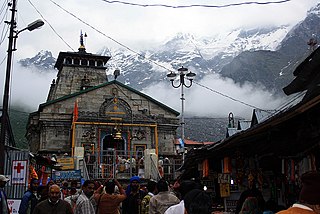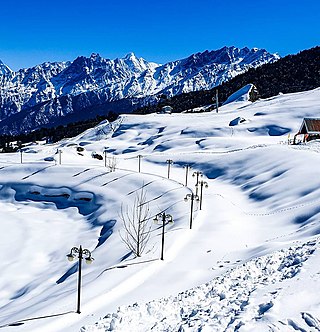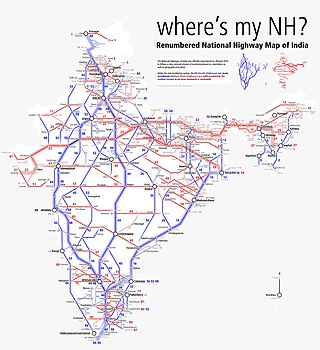
Garhwal is one of the two administrative divisions of the Indian state of Uttarakhand. Lying in the Himalayas, it is bounded on the north by Tibet, on the east by Kumaon, on the south by Uttar Pradesh state, and on the northwest by Himachal Pradesh state. It includes the districts of Chamoli, Dehradun, Haridwar, Pauri Garhwal, Rudraprayag, Tehri Garhwal, and Uttarkashi. The people of Garhwal are known as Garhwali and speak the Garhwali language. The administrative center for Garhwal division is the town of Pauri. The Divisional Commissioner is the administrative head of the Division, and is a senior Indian Administrative Service officer. As the administrative head of the division, the Commissioner is overall incharge of the 7 districts in the Garhwal region of Uttarakhand, and is aided in his duties by an additional commissioner and the district magistrates. Sushil Kumar is the divisional commissioner of the Garhwal Division since December 2021.

The Alaknanda is a turbulent Himalayan river in the Indian state of Uttarakhand and one of the two headstreams of the Ganges, the major river of Northern India and a river considered holy in Hinduism. In hydrology, the Alaknanda is considered the source stream of the Ganges on account of its greater length and discharge; while, in Hindu tradition and culture, the other headstream, the Bhagirathi, is considered the source stream.

Auli is in Chamoli district in the Himalayan mountains of Uttarakhand, India. Auli, also known as Auli Bugyal, in Garhwali, which means "meadow", is located at an elevation of 2,800 metres (9,200 ft) above sea level. Between June and October, the valley has one of highest numbers of flower species found anywhere in the world, with 520 species of high-altitude plants, 498 of which are flowering plants with significant populations of endangered species.

Devprayag is a town and a nagar panchayat, near New Tehri city in Tehri Garhwal District in the state of Uttarakhand, India, and is the final one of the Panch Prayag of Alaknanda River where Alaknanda meets the Bhagirathi river and both rivers thereafter flow on as the Ganges river or Ganga.
Paonta Sahib is an industrial town of Himachal Pradesh in India. It is located in the south of Sirmaur district, on National Highway 72. Paonta Sahib is an important place of worship for Sikhs, hosting a large Gurdwara named Gurudwara Paonta Sahib, on the banks of the river Yamuna. The river is the boundary between the states of Himachal Pradesh and Uttarakhand.

Karnaprayag is a town and municipal board in the Chamoli District in the Indian state of Uttarakhand. Karnaprayag is one of the Panch Prayag of Alaknanda River, situated at the confluence of the Alaknanda and Pindar River.

Rudraprayag is a city and a municipality in Rudraprayag district in the Indian state of Uttarakhand. Rudraprayag is one of the Panch Prayag of Alaknanda River, the point of confluence of rivers Alaknanda and Mandakini. Kedarnath, a Hindu holy city, is located 86 km from Rudraprayag. The man-eating leopard of Rudraprayag hunted and written about by Jim Corbett lived here.

The Doon Valley is an unusually wide, long valley within the Sivalik Hills and the Lesser Himalayas, in the Indian states of Uttarakhand, Himachal Pradesh and Haryana. Within the valley lies the city of Dehradun, the winter capital of Uttarakhand state.

The Satopanth glacier is situated in the Indian state of Uttarakhand. The river Alaknanda, one of the primary headstreams of the Ganges, has its origin in the Satopanth glacier. The glacier is one of the most popular glaciers in Uttarakhand among tourists. Mountaineers consider it somewhat challenging to scale.

This article is about the old number of Delhi-Meerut-Roorkee-Haridwar-Badrinath National Highway.

Sapta Badri constitutes a group of seven sacred Hindu temples, dedicated to god Vishnu, located in Garhwal Himalayas in the Indian state of Uttarakhand. The Badrinath temple, called the Badri Vishal is the primary temple among the seven shrines. The other six being Adi Badri, Bhavishya Badri, Yogadhayan Badri, Vriddha Badri, Ardha Badri and Dhyan Badri. The Panch Badri temple circuit consisted of only five temples, omitting Ardha Badri and usually Dhyan Badri. Rarely, Narasingh Badri, is included in the Sapta Badri or Panch Badri list.

Panch Prayag is an expression in Hindu religious ethos, specifically used to connote the five sacred river confluences in the Garhwal Himalayas in the state of Uttarakhand, India. The five prayags - prayaga meaning "place of confluence of rivers" in Sanskrit - also termed as "Prayag pentad" are Vishnuprayag, Nandaprayag, Karnaprayag, Rudraprayag and Devprayag, in the descending flow sequence of their occurrence.

Operation Surya Hope was the Indian Army’s Central Command response to the June 2013 North India floods in Uttarakhand.

National Highway 9 is a National Highway in India in east-west direction. It starts at Malout in Punjab and ends at Pithoragarh in Pithoragarh district in Uttarakhand. It passes through the states of Punjab, Haryana, Delhi, Uttar Pradesh and Uttarakhand. After renumbering of all national highways by National Highway Authority of India in 2010, the current NH 9 was formed by merging segments of five separate national highways in 2010; these were Old NH 10, Old NH 24, Old NH 87, Old NH 74 and Old NH 125.

National Highway 907 is an Indian National Highway starts from Paonta Sahib, Himachal Pradesh and ends at Yamuna Nagar, Haryana. The highway is 57 km (35 mi) long. Before renumbering of national highways of India, route of NH-907 was part of old national highway 73A.
National Highway 344 is a national highway in India running from Ambala in Haryana to Roorkee in Uttarakhand. It is a secondary route of National Highway 44. NH-344 runs in the states of Haryana, Punjab, Uttar Pradesh and Uttarakhand in India.

Char Dham National Highway, is an under construction two-lane 889 km long National Highway with a minimum width of 10 metres in the Indian state of Uttarakhand under Char Dham Pariyojana. The under construction highway will complement the under-construction Char Dham Railway by connecting the four holy places in Uttarakhand states namely Badrinath, Kedarnath, Gangotri and Yamunotri. The project includes 889 km national highways which will connect the whole of Uttarakhand state. It will connect Delhi–Dehradun Expressway on its southern end to India-China Border Roads on its northern ends.
The Char Dham Railway, the Indian Railways's under construction twin railway lines under Char Dham Pariyojana project by connecting the holiest places of Hinduism called Chota Char Dham, from the existing Doiwala railway station near Dehradun to Gangotri and Yamunotri via a fork at Uttarkashi and another set of twin rail links from the upcoming railway station at Karnaprayag to Kedarnath and Badrinath via a fork at Saikot. The line is also of strategic military importance and has been designated a national project.
Saikot is a village in the Chamoli district of Uttarakhand state in India. Situated on the banks of Alaknanda River, it is a proposed y-forked railway junction on Chota Char Dham Railway for two different railways going to Kedarnath and Badrinath.
The Rishikesh–Karnaprayag line is an under-construction railway line, which will run from Yog Nagari Rishikesh railway station in Rishikesh to Karnaprayag. It is Indian Railways' proposed route for the Char Dham Railway to connect the Char Dham pilgrimage of Uttarakhand. The line is also part of an Indian geostrategic initiative to build infrastructure along the India-China border to discourage Chinese expansion. The project is considered to be of national strategic importance and is being tracked on the Central Government’s PRAGATI portal. When ready, it will help improve connectivity to the Char Dham shrines of Yamunotri, Gangotri, Badrinath and Kedarnath in the Garhwal region of the Himalayas in Uttarakhand.






















